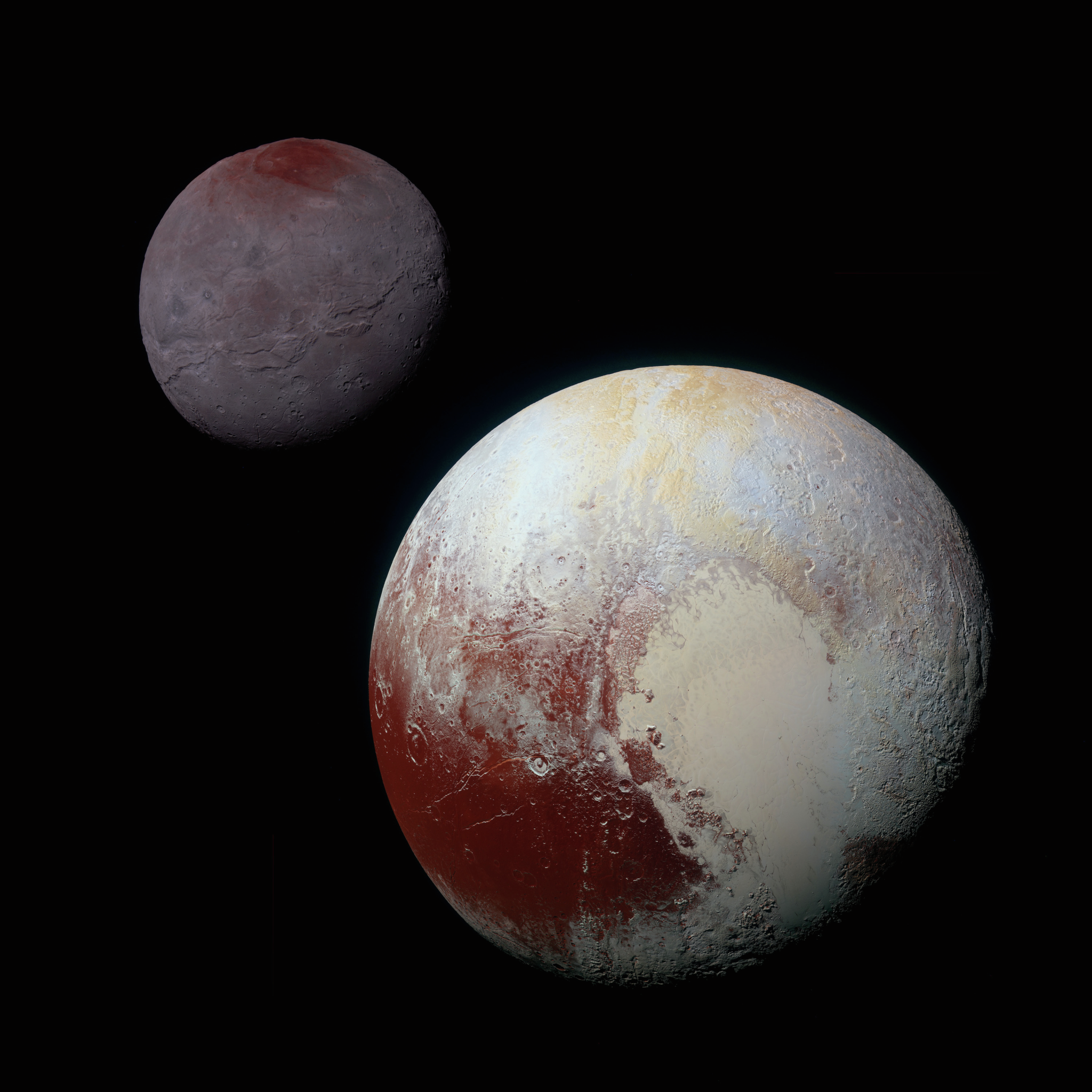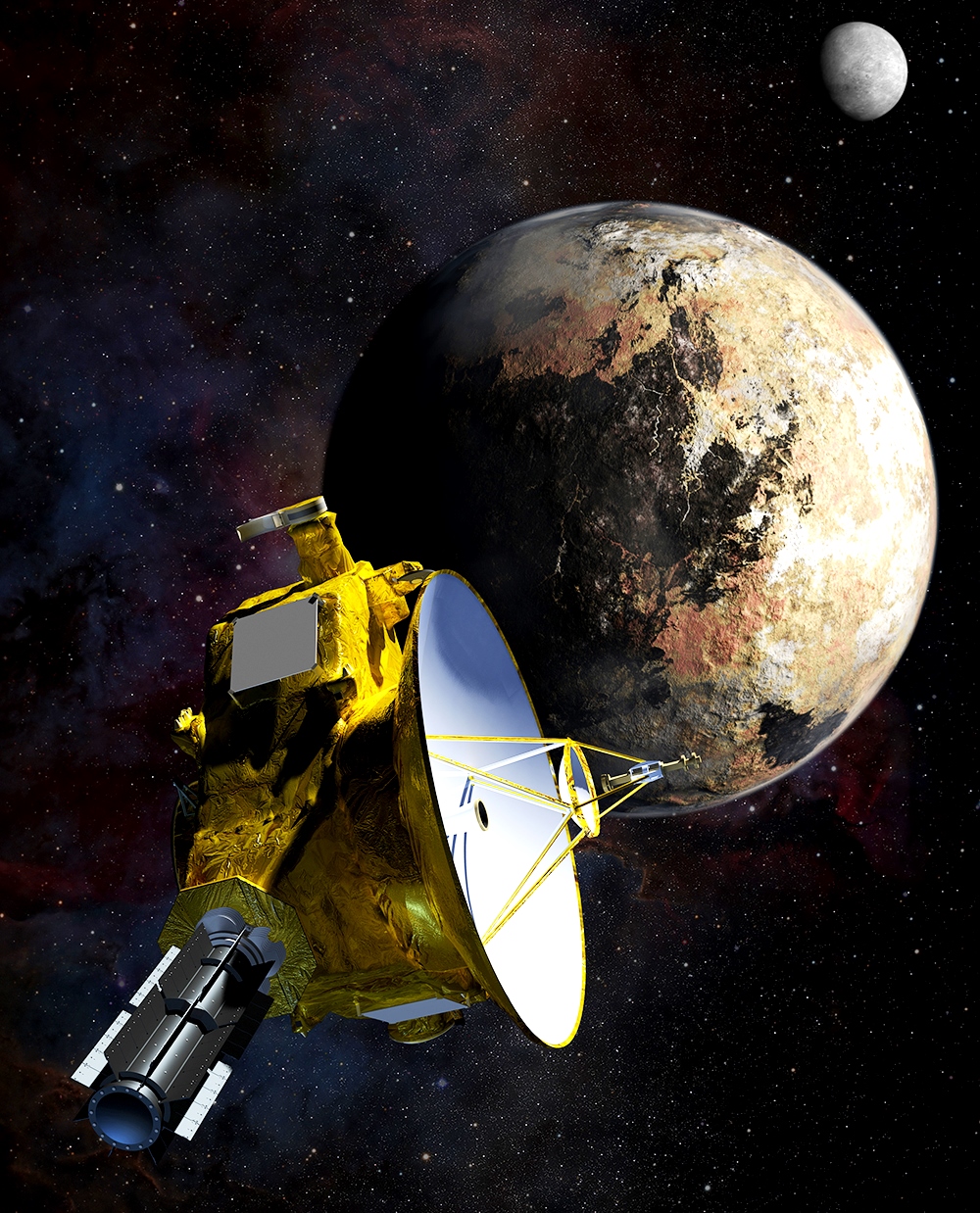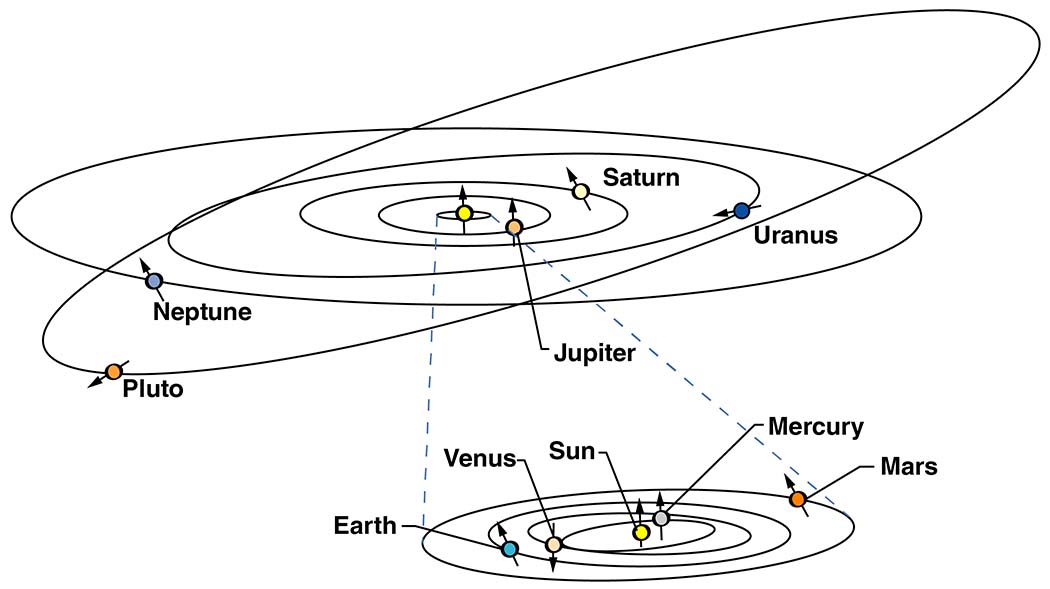This article is for students grades 5-8.
What Is Pluto?
Pluto is a dwarf planet, a Kuiper Belt object and a trans-Neptunian object.
Clyde Tombaugh, a U.S. astronomer, discovered Pluto in 1930. That same year, Venetia Burney, an 11-year-old girl from England, suggested it be named “Pluto” after the Roman god of the dead.
Pluto is a dwarf planet. A dwarf planet is round and orbits the sun just like the eight major planets of the solar system. A dwarf planet also is much smaller than a planet, but it is not a moon because a dwarf planet orbits the sun.
On average, Pluto is a distance of 39.5 astronomical units, or AU, from the sun. That is almost 40 times farther from the sun than Earth is. Because of its elliptical orbit, Pluto is not the same distance from the sun all the time. Pluto’s closest point to the sun is 29.7 AU. Getting this close means that Pluto sometimes crosses Neptune’s path. Neptune is 30 AU from the sun. Pluto’s farthest point away from the sun is 49.3 AU. Pluto is in a region called the Kuiper (KY-per) Belt. The Kuiper Belt is a large donut of thousands of small, icy objects that orbit the sun beyond Neptune.
____________________________________________________________________________________________
Words to Know
astronomer: a scientist who studies the stars, planets and other objects in outer space
astronomical unit (AU): the average distance from the sun to Earth — 149 million kilometers or 93 million miles. Earth is 1 AU from the sun.
elliptical: shaped like a flattened circle
____________________________________________________________________________________________
Pluto is only 2,370 kilometers (1,473 miles) wide. That is about half the width of the United States and smaller than Earth’s moon. Pluto takes 248 Earth years to make one revolution around the sun. That means one year on Pluto is about 248 Earth years. Pluto takes 6 1/2 Earth days/nights to rotate, so one day on Pluto is about 6 1/2 days/nights on Earth.
Pluto has five known moons. Its largest moon, named Charon (KAIR-uhn), is about half the size of Pluto. The U.S. Naval Observatory discovered Charon in 1978. Astronomers discovered Pluto’s four other moons — Nix, Hydra, Kerberos and Styx — using the Hubble Space Telescope. Each of these four moons is much smaller than Charon.
Scientists have found other objects like Pluto that are called dwarf planets. The first five dwarf planets that astronomers have identified in the solar system are Pluto, Ceres, Makemake (MAH-kay-MAH-kay), Haumea (HOW-may-ah) and Eris (AIR-riss). Scientists believe many more dwarf planets will be discovered.
Pluto itself may be classified in other ways. The dwarf planet is called a trans-Neptunian object. Trans-Neptunian objects are any objects in the solar system that have an orbit beyond Neptune. Pluto is also a Kuiper Belt object. The Kuiper Belt is a donut-shaped region of icy objects beyond the orbit of Neptune.
What Is Pluto Like?
It is very, very cold on Pluto. Scientists believe the temperature on Pluto is about minus 230 Celsius or minus 375 to minus 400 degrees Fahrenheit. It is 74 Celsius or 133 degrees Fahrenheit colder than the coldest temperature recorded in Antarctica. Pluto is so far away from Earth that scientists have known very little about what the surface is like until recently.
Pluto has about one-fifteenth the gravity of Earth. That means a person who weighs 45 kilograms or 100 pounds on Earth would weigh 3 kilograms or about 7 pounds on Pluto.
Most planets orbit the sun in a near-circle with the sun in the center. But Pluto’s orbit is an ellipse, and the sun is not in the center. Pluto’s orbit is also tilted compared to the orbits of the eight planets. The path on which Pluto orbits is angled 17 degrees above the line, or plane, where other planets orbit.
How Is NASA Exploring Pluto?
NASA has learned a lot about Pluto from studying images taken by the Hubble Space Telescope. Scientists used Hubble to take pictures of Pluto’s surface and to discover four of Pluto’s moons. But even though the telescope is powerful, Hubble’s images are fuzzy.
NASA sent a flyby mission for a close-up look at Pluto. A flyby mission is one in which the spacecraft does not land or stay in orbit of the body it is studying. Instead, the spacecraft for this type of mission uses cameras to study its target as it flies past.
NASA launched the piano-sized New Horizons spacecraft in January 2006 as the first mission to Pluto. New Horizons conducted a six-month flyby study of the dwarf planet in 2015. The spacecraft made its closest approach on July 14, 2015.
New Horizons has cameras that took pictures of Pluto. The spacecraft also has scientific instruments that gathered information. From the cameras and other instruments on New Horizons, NASA has learned many new facts about Pluto.
____________________________________________________________________________________________
Words to Know
density: the mass (quantity of matter) of a substance per unit volume (amount of space)
____________________________________________________________________________________________
Scientists have learned that the dwarf planet is about two-thirds rock and one-third ice. They concluded this from studying the pictures taken by New Horizons and by measuring Pluto’s density. Other images show that Pluto may have ice volcanoes. Instead of spewing lava like volcanoes on Earth, these volcanoes probably emit a cold, slushy mixture of water ice, nitrogen, methane and other substances. Mountains are made of giant blocks of frozen water (ice). Plains look like they are made of a frozen gas, nitrogen.
The mission has also shown us that Pluto’s moons are not like other moons. Most moons of the solar system always keep one face pointed toward the planets they orbit. Pluto’s four smaller moons spin so fast that they do not keep one face pointed to Pluto. Hydra spins fastest at 89 times for every orbit around Pluto! The smaller moons of Pluto also wobble much more than other moons. These moons wobble like spinning tops. Another difference between Pluto’s moons and other moons in the solar system is that it seems that at least two of Pluto’s moons were formed when two smaller, rocky bodies merged. So scientists believe that, at one time, Pluto had more than five moons.
After finishing the study of Pluto and its moons, New Horizons is moving on to study objects deeper in the Kuiper Belt. One of those objects is called 2014 MU69, which is 40 to 50 kilometers (30 miles) wide and more than a billion miles beyond Pluto.
Why Is NASA Exploring Pluto?
Exploring planets is a historic endeavor and a major focus of NASA. Spacecraft have visited all eight planets in the solar system. NASA seeks to answer fundamental questions: How did our solar system form and evolve? Is there life beyond Earth? What are the hazards to life on Earth? Studying Kuiper Belt objects like Pluto may help scientists learn more about how planets form.
NASA has several types of missions to study planets and other bodies in space: flybys, orbiting spacecraft, landers, and rovers. Sometimes NASA conducts a sample-return mission to bring rocks or soil from another body to Earth. Each type of mission helps advance human understanding of the chemical and physical history of the solar system.
Check these links to stay up to date on what NASA has learned about Pluto from New Horizon’s studies of the dwarf planet:
New Horizons: NASA’s Mission to Pluto http://pluto.jhuapl.edu/index.php
More About Pluto
Pluto Infographic and Overview
Fun Facts About Pluto
Peculiar Pluto
Pluto in a Minute Playlist
What We Know About Pluto
Space Place: What Is the Kuiper Belt?
10 Need-to-Know Things About Dwarf Planets
Space Shorts: What Is a Dwarf Planet? Video
Space Place in a Snap: The Solar System’s Formation































